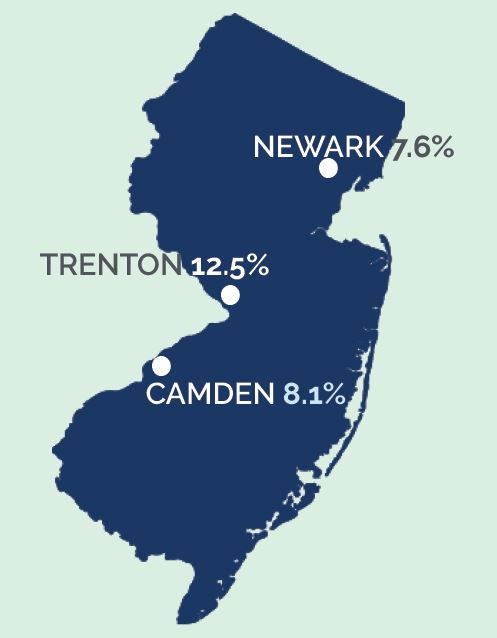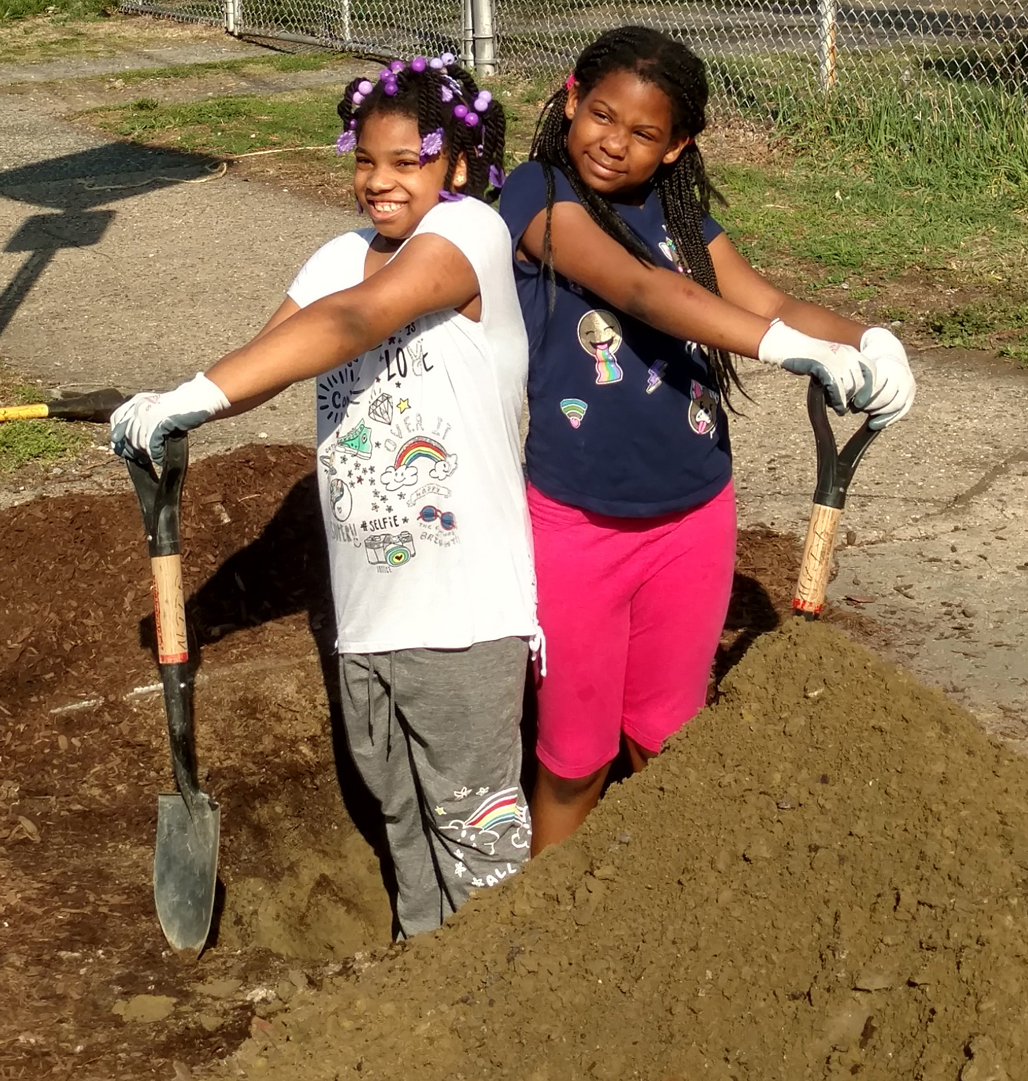Context
It is fitting that New Jersey is nicknamed the “Garden State”: with a tree canopy cover of almost 44%, the state is home to more than 152 million trees that remove almost a million metric tons of carbon and over 30,000 metric tons of harmful air pollution annually. However, these living green amenities are not uniformly distributed throughout the state. In New Jersey’s urban areas – specifically, Trenton, Newark, and Camden – tree canopy cover averages 12.5%, 7.6% and 8.1%, respectively. These statistics are part and parcel of a long-standing nation-wide trend of tree canopy coverage disparities falling along racial and income lines. By now, it is well documented that neighborhoods of color have around half as much canopy cover as historically white, affluent neighborhoods. Fewer trees invariably means higher rates of human diseases associated with increased exposure to air pollution, along with heightened risk from the effects of climate change – huge temperature differentials as unshaded neighborhoods heat up; and increased heavy rainfall, with nowhere to go, regularly flooding streets and basements.
Rightfully, these disparities are increasingly being recognized as an environmental justice issue that demands to be addressed with great care and conviction. Since 1998, The New Jersey Tree Foundation (NJTF) has put community residents at the center of their mission to increase tree canopy in underserved, overburdened, and marginalized neighborhoods.
Start Small, and Ask to be Invited
Planting trees in underserved neighborhoods has been described as a transformative experience by residents and NJTF volunteers. When Lisa Simms, NJTF’s executive director, arrived at her first tree planting in the city of Camden over 17 years ago, she was met not by the nursery truck driver delivering the trees, but by two very skeptical plain clothes police officers. Simms recounts, “When they learned that I was there to plant 25 trees with the community and Habitat for Humanity, the officers laughed and said ‘You’re crazy, you know that? This is Camden. No one wants trees here. They’ll be gone by the morning.’” They watched as NJTF, Habitat For Humanity, and every single resident on the block all planted the trees together. By the time they were finished, the officers were convinced that this initiative was different.
As a rule, NJTF only plant trees where they are invited, to ensure that there is a critical mass of residents on the ground with a willingness to care for and protect the trees they helped to plant.
“Even as a community organization, you have to be invited. No one likes it when somebody stops by unannounced,” says Simms. She differentiates her foundation’s tactic of slow and steady with the standard operating procedure of most other foundations and planning authorities, which tend to amass millions of dollars for big multi-year projects. “Our annual efforts aren’t huge – we aren’t planting thousands of trees a year, and we don’t want to do that, because the neighbors can’t keep up with the maintenance and care,” she adds. “What we want to avoid is a dead tree. A dead tree is worse than no tree: it says so much more.”
Resident partnership is at the core of NJTF’s model: they are involved from the beginning to end, from picking out what tree species they want in front of their property, to organizing other residents on their block, to tree placement, planting, and maintenance. Before a single tree is planted, residents sign a two-year maintenance agreement that spells out clearly how to care for their tree, including proper watering, mulching, and pruning techniques. NJTF’s TreeKeepers program provides volunteer residents with a half-day training on the different aspects of tree care, as well as free tools. Sometimes NJTF brings their Green Streets crew to do advanced pruning and share their knowledge of urban forestry with neighbors.

The foundation visualizes effective engagement as tendrils reaching throughout the community, with a year round, broadly supportive presence. “We have never hired foresters, we hire people with people skills, who are really good and comfortable talking to anybody about anything,” explains Simms. With only five employees, NJTF relies heavily on its thousands of volunteers to get their hands dirty. Limited staff also requires a smart tactical strategy that leverages resources to yield big long-term results. Unlike more flush organizations that have social media managers and communication directors, NJTF does most of their marketing by word of mouth.
And this small and steady strategy has led to big impacts. To date, NJTF has planted over 257,000 trees across the state, with over 7,000 in Camden, over 3,588 in Newark and 150 in Trenton – a city where they are just starting to focus their efforts.
Leverage Short-term Opportunities into Long-term Programs
NJTF was provided short-term opportunities that it has turned into self-sustaining programs that are thriving today. Two programs resulted from its partnership with the NJDEP NJ Urban and Community Forestry program and financing from the NJDEP Natural Resource Damages program: the former a $1 million grant to plant trees in the ozone non-attainment area of south jersey, and the latter a $1.8 million grant to plant thousands of trees across several counties. With a large area to cover in 2006, NJTF had to ramp up capacity, and fast, which resulted in the development and launch of their Green Streets program. Every tree-planting season, the NJTF partners with the New Jersey Parole Board to identify parolees. Green Streets then provides seasonal employment that combine on the job training, skills development, and supportive services. “I had worked with a lot of parolees and people on work release in my last job, and I knew this was a group of people who needed jobs and were facing serious barriers to getting them. I thought, these are amazing men; we can train them, and then they can get hired on by nurseries and landscapers who were experiencing worker shortages,” explains Simms.
Even though the original grant money has long been spent, NJTF has continued to fund the Green Streets Program by phasing in a fee-for-service model. Through a partnership with Rutgers University, training has extended beyond tree planting and maintenance to include rain garden design, installation, and upkeep. In the past 14 years, over 16,500 trees were planted under this program, and over one hundred parolees have transitioned to full and stable employment.
Simms largely credits the success of the program to the dedication and resourcefulness of her Crew Manager, James Cunningham. Cunningham was one of the first graduates of the program and has been with NJTF ever since. Their mutual dependence exemplifies the many life-changing aspects of including and uplifting marginalized people in beautification and resiliency work. “The Green Streets Program gave me a career—a career I enjoy getting up for every morning. It taught me leadership and how to appreciate trees and flowers,” states Cunningham.
Lessons Learned
Going slow and steady, so far, has been the secret to NJTF’s success. But the urge to go big and fast is becoming tempting even for them as the effects of climate change are becoming more and more apparent. For decades, NJTF successfully maintained an unprecedented 95% survival rate for community-based tree plantings, but Simms sees this number slipping as a result of now regular seasonal flooding. “Many of our tree saplings from the last three years have ended up stone dead because they are just sitting in water. We have no problem helping with watering during drought, but there isn’t much we can do about flooding.”
What’s next? The organization plans to grow, slowly, branching out to underserved neighborhoods in Gloucester, Jersey City, and Atlantic City. By prioritizing the quality of work and keeping residents at the core of their mission, they may very well weather any storms to come.

